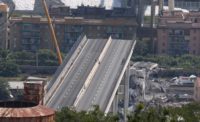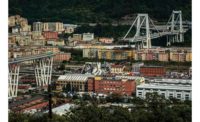Based on the current pace of construction, a 19-span replacement for the ill-fated Polcevera viaduct in Genoa, Italy, will open to traffic before investigators identify the cause of its disastrous collapse last year and prosecute any culpable individuals.
The 1.1-kilometer-long viaduct is on course to open next spring, months before the second anniversary of the partial collapse of the old post-tensioned concrete structure that caused 43 deaths and severed connections across the port city.
Aided by accelerated permitting and procurement, the PerGenova consortium placed the first, 450-tonne steelwork deck section onto newly cast concrete piers on Oct. 1, less than six months after starting work.
Designed by local architect Renzo Piano, the continuous steel box girder deck will sit on 18 piers to form the new 1,067-meter-long viaduct some 45 m high.
Crossing the Polcevera River and adjacent railroad, three central spans will be 100 m long while most of the others will be half that length. The aerodynamic deck will be around 27 m wide, nearly 5 m deep and topped with 27 cm of concrete cast compositely.
To get the replacement built quickly, the government last October appointed Genoa mayor Marco Bucci as Special Commissioner for Reconstruction. Because the new viaduct largely followed the existing route, permitting was fast.
To quickly procure the design-build contract, the commissioner negotiated with various companies without the open bidding normally required by European Union rules because of the urgent need to reopen the major E25 east-west highway.
Last December, four months after the collapse, the commissioner awarded the $222-million contract to PerGenova, which is equally owned by the country’s largest contractor, Salini Impregilo S.p.A., and the construction unit of state-controlled ship builder Fincantieri S.p.A.
Fincantieri Infrastructure is handling fabrication and erection of the roughly 17,000 tonnes of steelwork while Salini Impregilo is responsible for concrete and foundation work. PerGenova’s designer is Italferr S.p.A., owned by Italy’s state railroad company.
With rubble of the old viaduct removed, PerGenova began work this April, but site access constraints delayed the start of work in some areas by weeks, says the consortium’s CEO, Salini Impregilo’s Nicola Meistro. The target 12-month construction schedule will be tough to achieve, he adds, but he still hopes to complete the project next spring.
Piling started in mid-April. As pier work spread along the viaduct, the first nine deck modules, weighing up to 50 tonnes each, arrived in early July from Fincantieri’s plant in Castellammare di Stabia, south of Naples. By this summer, all the piers were at various stages of completion while steelwork continued arriving by boat from nearby Sestri Ponente and on trucks from Valeggio sul Mincio, Verona.
Fincantieri is assembling the modules on site into complete deck sections, generally weighing about 800 tonnes, and will lift them with strand jacks onto the piers. Meistro expects steelwork erection to end by February. Then the contractor will place precast slabs on the steel and cast concrete on them to form the deck.
Autostrade per Italia S.p.A., the viaduct’s privately controlled operator, has committed $550 million for construction and associated costs, and expects to operate the viaduct when it opens. Meanwhile, the company rebuts accusations of inadequate maintenance and challenges government threats to terminate its concession covering nearly 3,000 km of Italian motorways.
Two spans of the former, 51-year-old viaduct, also known as the Morandi bridge after its designer Riccardo Morandi, collapsed on Aug. 14, 2018. The unusual structure included decks that each supported large post-tensioned stays from concrete A-frame pylons and intermediate props leaning out from the piers.
Numerous theories of the cause of collapse have been floated, mainly relating to tendon corrosion. But investigators have yet to reach any conclusions. While engineers probe the evidence, more than 70 individuals from various organizations are reportedly under investigation by the Genoa public prosecutor, potentially facing criminal trial at some undetermined date.






_enrready.jpg?height=200&t=1611166905&width=200)

Post a comment to this article
Report Abusive Comment